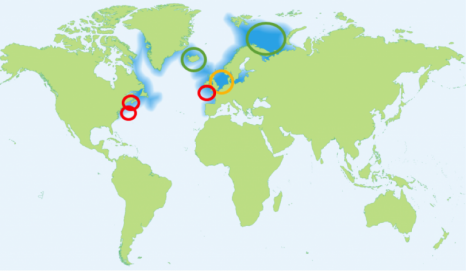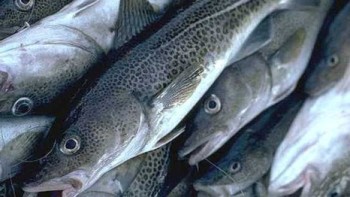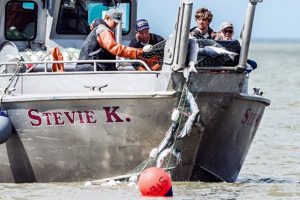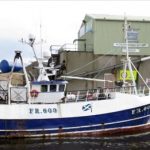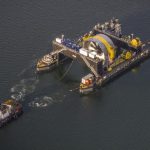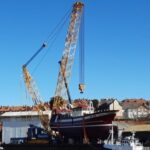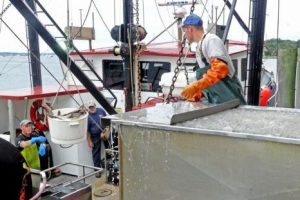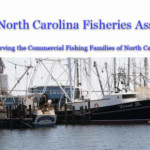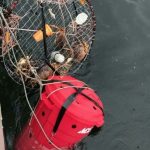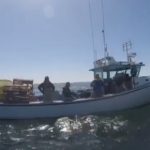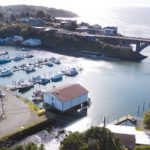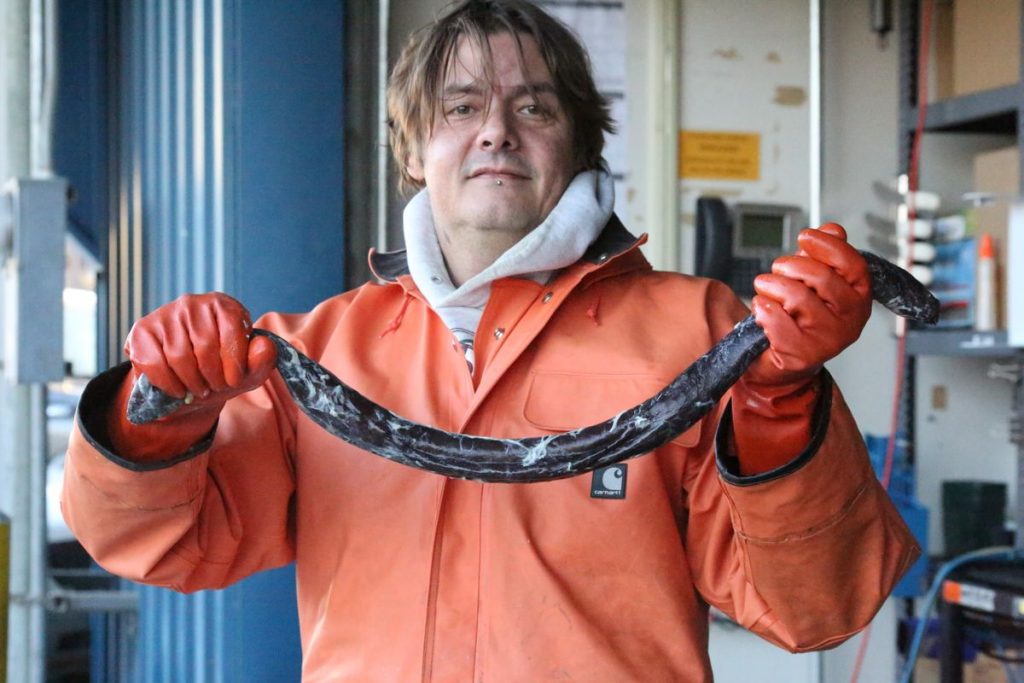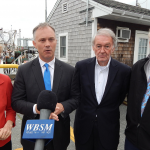Tag Archives: Georges Bank
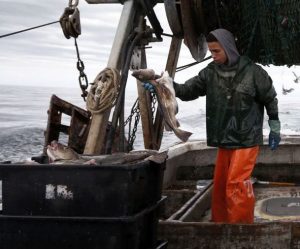
New England: Centuries-old cod fishery had worst year in history in 2017
One of the most historic fisheries in the country hit an all-time low last year as cod fishermen continued to struggle with choking quotas and low abundance of the fish. Maine’s cod fishery has existed since at least the early 17th century, and it was once one of the strongest in the country. The fishery peaked at more than 21 million pounds of cod, a fish often used with the fish and chips dish, in 1991.,,, One reason for the collapse is that federal quotas for cod are so low many fishermen are just avoiding them altogether, said Terry Alexander, a veteran fisherman out of Portland and Boston. Cod fishermen typically also seek other species, such as haddock and flounder, and they must stop fishing altogether once they reach quota for cod, per the rules. >click to read<11:15
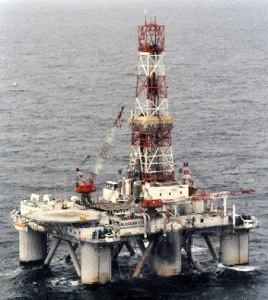
July 27, 1981: Oil drilling begins on Georges Bank – ”It’s only a matter of time before the fishermen get used to having us out here.”
On this day in 1981, the New York Times reported on the start of drilling for oil in Georges Bank. It was not to be, however, as the first President George Bush later proclaimed a federal edict which prohibited all offshore oil exploration, at least until today when his son has rescinded that presidential edict. Eight exploratory wells were dug to average depths of 16,000 feet about 125 miles east of Cape Cod through early 1982. At 4:57 P.M., Wes Campbell, a driller working for the Shell Oil Company, lowered a column of steel pipe deep into the Atlantic, 200 miles off the coast of Massachusetts. >click to read<08:14
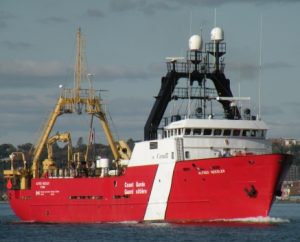
DFO trawl surveys – Fishery decisions shored up on flawed science
As unintentional metaphors go, it was strangely apt: a reader with ties to federal fisheries science wrote to me to tell me that a recent column on problems with that science, “only scratched the surface.” In some ways, that seems like a perfect description of the problem. What I’d written about was the use of a contracted private fishing trawler to do a shortened annual fisheries survey on George’s Bank. The vessel was going to do the survey in 11 days – the work normally takes five weeks, and is done by one of two federal fisheries vessels,,, >click to read< 09:17
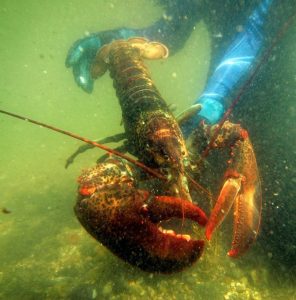
Benchmark study of lobsters begins
In 2015, data collected in a benchmark assessment of New England lobster stocks showed record-high abundance for the combined stocks of the Gulf of Maine and Georges Bank and record lows for the lobster stock of southern New England. Now, about three years later, the Atlantic States Marine Fisheries Commission is beginning preparations for the next American lobster benchmark assessment that is expected to be completed around March 2020. “We’re in the very early stages right now,” said Jeff Kipp, senior stock assessment scientist at the Arlington, Virginia-based ASMFC that regulates the Northeast lobster fishery. “The process will be mostly data-driven.” >click to read< 21:10

Why the Trump offshore drilling plan is another Canada-U.S. complication
As much as half a million kilograms of haddock caught on the rich fishing grounds of Georges Bank this weekend will be landed in ports in southwestern Nova Scotia, as the winter fishery gets underway after a storm-delayed start to 2018.,,, Canada and the U.S. jointly manage fisheries on Georges Bank through various trans-boundary committees that agree on quotas, resource sharing and stock health. >click here to read<

NMFS Approves “Majority” of Council’s Habitat Amendment
NOAA’s National Marine Fisheries Service (NMFS) has approved –with two exceptions –the New England Fishery Management Council’s Omnibus Essential Fish Habitat Amendment 2 (OHA2), paving the way for sweeping change to the existing network of closed and management areas in the Gulf of Maine, Southern New England, and Georges Bank. The changes will provide better protection for both fish and habitat while eliminating closures that no longer serve their intended purpose. click here to read the press release 16:20

Trump administration’s offshore drilling plans make one Nova Scotia fish processor very nervous
A U.S. government plan to expand offshore drilling in its waters could give oil and gas companies access to ecologically sensitive areas, including the American half of Georges Bank, a prospect that makes one Nova Scotia fish processor very nervous. Georges Bank is a large elevated area of sea floor that separates the Gulf of Maine from the Atlantic Ocean and is an important breeding ground for several fish species. It’s an area far too important to the fishing industry to be endangered by drilling, according to Nathan Blades, the general manager of Sable Fish Packers on Cape Sable Island in southwest Nova Scotia. click here to read the story 13:35
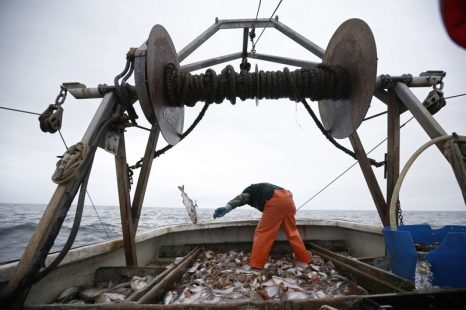
Omnibus Essential Fish Habitat Amendment – Plan to change New England ocean stewardship up for debate
The federal government is close to enacting new rules about New England ocean habitat that could mean dramatic changes for the way it manages the marine environment and fisheries. The National Marine Fisheries Service has been working on the rules for some 13 years and recently made them public. They would change the way the government manages the Gulf of Maine, Georges Bank and southern New England waters, which are critical pieces of ocean for rare whales, unique underwater canyons and commercial fishermen.,, The proposal states that its goal is to minimize “adverse effects of fishing on essential fish habitat.” click here to read the story 10:50
Series of coral protection hearings planned for New England
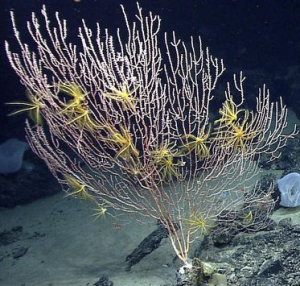 Federal fishery managers will hold a host of public hearings in New England and New York about a plan to protect corals in key East Coast fishing areas. The New England Fishery Management Council is hosting seven public hearings about alternatives it is considering about the protection of corals in the Gulf of Maine and Georges Bank. The hearings will take place from May 22 to 25 in Montauk, Narragansett, New Bedford, Gloucester, Portsmouth, and Ellsworth. There will also be a web-based hearing on May 26. The fishery council says it wants to collect feedback from fishermen and other stakeholders about the coral protection Link 21:28
Federal fishery managers will hold a host of public hearings in New England and New York about a plan to protect corals in key East Coast fishing areas. The New England Fishery Management Council is hosting seven public hearings about alternatives it is considering about the protection of corals in the Gulf of Maine and Georges Bank. The hearings will take place from May 22 to 25 in Montauk, Narragansett, New Bedford, Gloucester, Portsmouth, and Ellsworth. There will also be a web-based hearing on May 26. The fishery council says it wants to collect feedback from fishermen and other stakeholders about the coral protection Link 21:28
Haddock Boom! The number of haddock believed to have survived their first year off N.S. is “extraordinary,” says biologist
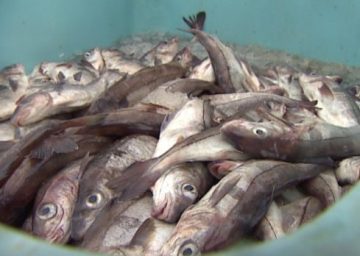 Exactly how many of the haddock that hatched in 2013 are still swimming off the coast of southern Nova Scotia is not certain, but researchers agree the numbers are potentially massive. Biologist Monica Finley recently completed a population assessment for the southern Scotian Shelf and Bay of Fundy. She estimates 264 million haddock were hatched there in 2013 and survived their first year, making it an “extraordinary” year-class. “This 2013 year-class is five times higher than the next highest on record since 1985,” said Finley, who works at a Department of Fisheries and Oceans research facility in St. Andrews, N.B. Her report predicts 100,000 metric tonnes of haddock will reach adulthood in 2017 and 2018. On Georges Bank, the population is predicted to be even bigger, with Canadian and American scientists estimating the 2013 hatch at 1.3 billion fish. Read the story here 18:36
Exactly how many of the haddock that hatched in 2013 are still swimming off the coast of southern Nova Scotia is not certain, but researchers agree the numbers are potentially massive. Biologist Monica Finley recently completed a population assessment for the southern Scotian Shelf and Bay of Fundy. She estimates 264 million haddock were hatched there in 2013 and survived their first year, making it an “extraordinary” year-class. “This 2013 year-class is five times higher than the next highest on record since 1985,” said Finley, who works at a Department of Fisheries and Oceans research facility in St. Andrews, N.B. Her report predicts 100,000 metric tonnes of haddock will reach adulthood in 2017 and 2018. On Georges Bank, the population is predicted to be even bigger, with Canadian and American scientists estimating the 2013 hatch at 1.3 billion fish. Read the story here 18:36
Moratorium on oil and gas activities on Canadian portion of Georges Bank in affect
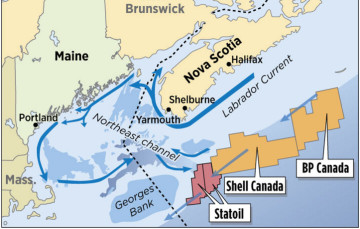 The sustainability and health of one of North America’s most valuable marine ecosystems will be better protected thanks to ongoing collaboration between the governments of Canada and Nova Scotia. The Honourable Jim Carr, Canada’s Minister of Natural Resources, and his provincial counterpart, the Honourable Michel Samson, Minister of Energy for Nova Scotia, have enacted a statutory moratorium on oil and gas activities in the of Georges Bank. The moratorium took effect April 15. Georges Bank, a large submarine bank at the edge of the Atlantic continental shelf between Cape Cod and Nova Scotia, provides habitat for a wide range of marine fish, mammals and corals. As one of the world’s most productive fishing grounds, Georges Bank also supports important commercial fisheries. Read the rest here 15:53
The sustainability and health of one of North America’s most valuable marine ecosystems will be better protected thanks to ongoing collaboration between the governments of Canada and Nova Scotia. The Honourable Jim Carr, Canada’s Minister of Natural Resources, and his provincial counterpart, the Honourable Michel Samson, Minister of Energy for Nova Scotia, have enacted a statutory moratorium on oil and gas activities in the of Georges Bank. The moratorium took effect April 15. Georges Bank, a large submarine bank at the edge of the Atlantic continental shelf between Cape Cod and Nova Scotia, provides habitat for a wide range of marine fish, mammals and corals. As one of the world’s most productive fishing grounds, Georges Bank also supports important commercial fisheries. Read the rest here 15:53
Gulf of Maine lobster stock at an all-time high
 A recent lobster stock assessment shows the population of the state’s famous bottom-dwelling crustacean at record highs in the Gulf of Maine. Through data collected by fishery-dependent and fishery-independent sources, the stock assessment gives fishermen and scientists a picture of the condition of the economically important stock. According to the Atlantic States Marine Fisheries Commission, the 2015 benchmark stock assessment for lobsters shows the stock of crustaceans in the Gulf of Maine and Georges Bank is not depleted and overfishing is not occurring. However, the situation for the stock in southern New England is far less clear,,, Read the article here 12:52
A recent lobster stock assessment shows the population of the state’s famous bottom-dwelling crustacean at record highs in the Gulf of Maine. Through data collected by fishery-dependent and fishery-independent sources, the stock assessment gives fishermen and scientists a picture of the condition of the economically important stock. According to the Atlantic States Marine Fisheries Commission, the 2015 benchmark stock assessment for lobsters shows the stock of crustaceans in the Gulf of Maine and Georges Bank is not depleted and overfishing is not occurring. However, the situation for the stock in southern New England is far less clear,,, Read the article here 12:52
HELLO!!!! Canada approves offshore oil exploration near Maine
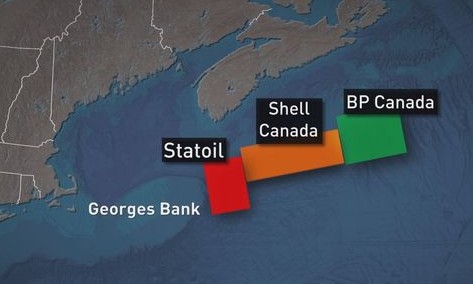 Oil drilling near Maine’s coastline is causing some concern for fishermen and environmentalists. The government of Canada has given the go-ahead to a Norweigan oil company to look for oil near where water enters the Gulf of Maine. That’s just 225 miles from Bar Harbor and right next to the important fishing ground of George’s Bank. Oil drilling off Nova Scotia has happened for decades. What makes this exploration different is its proximity to one of New England’s most important fishing grounds. Read the article here 20:18
Oil drilling near Maine’s coastline is causing some concern for fishermen and environmentalists. The government of Canada has given the go-ahead to a Norweigan oil company to look for oil near where water enters the Gulf of Maine. That’s just 225 miles from Bar Harbor and right next to the important fishing ground of George’s Bank. Oil drilling off Nova Scotia has happened for decades. What makes this exploration different is its proximity to one of New England’s most important fishing grounds. Read the article here 20:18
Oh No Canada. Nova Scotia approves oil exploration lease next to Georges Bank, entrance to Gulf of Maine
 In a move opposed by fishermen, Canadian authorities have granted the company an exploratory lease for the area 225 miles southeast of Bar Harbor and bordering on the eastern flank of Georges Bank. Environmentalists fear drilling could leave the ecologically sensitive Gulf of Maine susceptible to a catastrophic oil spill. It would be the closest that exploratory drilling has come to Maine since the early 1980s. Five wells were drilled on the U.S. side of Georges Bank in 1981 and 1982, before U.S. and Canadian moratoriums were put in place to protect the fishing grounds. Read the article here 06:27
In a move opposed by fishermen, Canadian authorities have granted the company an exploratory lease for the area 225 miles southeast of Bar Harbor and bordering on the eastern flank of Georges Bank. Environmentalists fear drilling could leave the ecologically sensitive Gulf of Maine susceptible to a catastrophic oil spill. It would be the closest that exploratory drilling has come to Maine since the early 1980s. Five wells were drilled on the U.S. side of Georges Bank in 1981 and 1982, before U.S. and Canadian moratoriums were put in place to protect the fishing grounds. Read the article here 06:27
Georges Bank drilling moratorium extended by Nova Scotia government
 The Nova Scotia government is extending the Georges Bank moratorium on oil and gas exploration and drilling. The fishing bank has been off limits since 1988. This extends the protection until at least 2022. Ottawa passed a similar protection bill last June. Such exploration comes under the joint jurisdiction of the provinces and federal government. BP and Chevron have drilling and exploration rights in the region, but will remain unable to use those leases. Read the article here 09:07
The Nova Scotia government is extending the Georges Bank moratorium on oil and gas exploration and drilling. The fishing bank has been off limits since 1988. This extends the protection until at least 2022. Ottawa passed a similar protection bill last June. Such exploration comes under the joint jurisdiction of the provinces and federal government. BP and Chevron have drilling and exploration rights in the region, but will remain unable to use those leases. Read the article here 09:07
Shell approval for oil drilling off Nova Scotia raises alarms in fishing industry
 The approval from the Canada-Nova Scotia Offshore Petroleum Board to allow Shell Canada to drill two oil wells on the edge of the Scotian Shelf is raising alarm bells among some in the fishing industry. “Four of those leases are directly in the major fishing banks of the Scotian Shelf,” said Davis, the former head of an anti-drilling group called the No Rigs Coalition. “Two are contiguous to the moratorium area of Georges Bank, two are to the northeast of Georges Bank and one takes in the southern part or heel of Browns Bank. The Scotian Shelf industry is under assault from the oil and gas industry.” Read the rest here 15:02
The approval from the Canada-Nova Scotia Offshore Petroleum Board to allow Shell Canada to drill two oil wells on the edge of the Scotian Shelf is raising alarm bells among some in the fishing industry. “Four of those leases are directly in the major fishing banks of the Scotian Shelf,” said Davis, the former head of an anti-drilling group called the No Rigs Coalition. “Two are contiguous to the moratorium area of Georges Bank, two are to the northeast of Georges Bank and one takes in the southern part or heel of Browns Bank. The Scotian Shelf industry is under assault from the oil and gas industry.” Read the rest here 15:02
Northeast Fisheries Science Center say’s key fishing area for Atlantic cod in dire shape
New data from the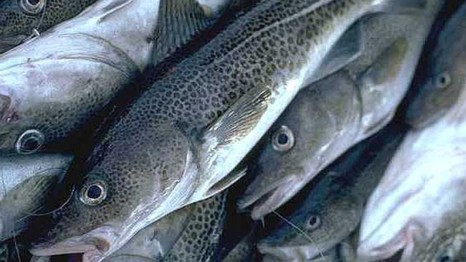 says research boats caught less of the fish this past spring than in all but one spring season dating back to 1968. A report from the centre, given to The Associated Press on Tuesday, states that the boats caught about 3.3 pounds of cod each time the net went in and out of the water last spring, compared to more than three times that amount two years earlier. “Is that coming as a surprise from anybody who knows what the water temperature is out there? No, it shouldn’t be,” said David Goethel, a New Hampshire-based fisherman. “These fish are declining because of climate change.” Read the rest here 22:13
says research boats caught less of the fish this past spring than in all but one spring season dating back to 1968. A report from the centre, given to The Associated Press on Tuesday, states that the boats caught about 3.3 pounds of cod each time the net went in and out of the water last spring, compared to more than three times that amount two years earlier. “Is that coming as a surprise from anybody who knows what the water temperature is out there? No, it shouldn’t be,” said David Goethel, a New Hampshire-based fisherman. “These fish are declining because of climate change.” Read the rest here 22:13
Environmentalists are upset over NEFMC Georges Bank vote
 Peter Shelley, senior attorney for the Conservation Law Foundation, charged that the council ignored years of scientific data and analysis and “caved to industry pressures” regarding Georges Bank. (The council did approve four other areas of habitat protection.) “The council hammered the final nail into the coffin of what could have been a landmark victory for ocean habitats protection in New England,” Shelley wrote on his organization’s web site. Dr. Sarah Smith, a member of the Fisheries Solutions Center at the Environmental Defense Fund, wrote The Standard-Times in an e-mail, “We are disappointed that the council,,, Read the rest here 09:14
Peter Shelley, senior attorney for the Conservation Law Foundation, charged that the council ignored years of scientific data and analysis and “caved to industry pressures” regarding Georges Bank. (The council did approve four other areas of habitat protection.) “The council hammered the final nail into the coffin of what could have been a landmark victory for ocean habitats protection in New England,” Shelley wrote on his organization’s web site. Dr. Sarah Smith, a member of the Fisheries Solutions Center at the Environmental Defense Fund, wrote The Standard-Times in an e-mail, “We are disappointed that the council,,, Read the rest here 09:14
New England Council Votes to Open Up Parts of George’s Bank to Commercial Fishing
 NEWPORT, R.I. – Regional fishery regulators meeting in Rhode Island have voted to open up parts of George’s Bank – off of Massachusetts – to commercial fishing. The New England Fishery Management Council has approved a plan that it says will allow fishing opportunities on healthy stocks for the economically strapped groundfish fleet. In a statement, the council says the plan also allows greater access to a portion of the Georges Bank sea scallop resource that has not been open to the fishery since 1994. CLF crowd feeling bummed. Read the rest here 20:51
NEWPORT, R.I. – Regional fishery regulators meeting in Rhode Island have voted to open up parts of George’s Bank – off of Massachusetts – to commercial fishing. The New England Fishery Management Council has approved a plan that it says will allow fishing opportunities on healthy stocks for the economically strapped groundfish fleet. In a statement, the council says the plan also allows greater access to a portion of the Georges Bank sea scallop resource that has not been open to the fishery since 1994. CLF crowd feeling bummed. Read the rest here 20:51
Good News for Georges Bank! – Drilling Moratorium Extended, strong landings of lobster, haddock and scallops
 The announcement in Finance Minister Joe Oliver’s budget that the federal government will join with the Nova Scotia government to legislate an extension to the Georges Bank moratorium adds to a recent spate of good news for the province’s fishing and seafood industry, says Denny Morrow,,, The coalition issued a news release saying strong landings of lobster, haddock and scallops; the lower Canadian dollar; and good demand for those seafood exports in U.S. and Asian markets are creating a feeling of optimism in the industry. Read the rest here 17:30
The announcement in Finance Minister Joe Oliver’s budget that the federal government will join with the Nova Scotia government to legislate an extension to the Georges Bank moratorium adds to a recent spate of good news for the province’s fishing and seafood industry, says Denny Morrow,,, The coalition issued a news release saying strong landings of lobster, haddock and scallops; the lower Canadian dollar; and good demand for those seafood exports in U.S. and Asian markets are creating a feeling of optimism in the industry. Read the rest here 17:30
NEFMC fails to agree on scallopers’ wish to enter long-closed areas
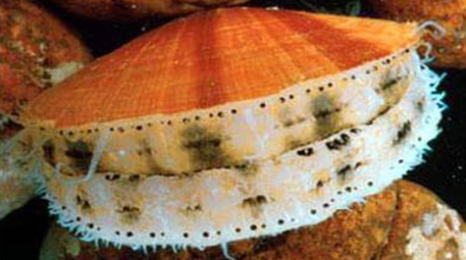 Thursday the council failed to come to terms about the specifics of the plan in Georges Bank, which centers on an area on the Canadian line called the Northern Edge. On Wednesday the council approved several measures in the Gulf of Maine, delineating protected areas where certain forms of fishing gear will not be permitted. Georges Bank was another matter. NOAA
Thursday the council failed to come to terms about the specifics of the plan in Georges Bank, which centers on an area on the Canadian line called the Northern Edge. On Wednesday the council approved several measures in the Gulf of Maine, delineating protected areas where certain forms of fishing gear will not be permitted. Georges Bank was another matter. NOAA Fisheries regional administrator John Bullard had signaled his disapproval of preliminary plans on the grounds that they weren’t protective enough of habitat. And when council member introduced an amendment to make the plan more acceptable to NOAA fisheries, the meeting collapsed into disarray. Read the rest here 08:28
NEFMC Approve Some Habitat Changes – blocks no-fishing zone for scientific research on Stellwagen Bank
Federal fishery regulators say they will keep much-debated protections for Cashes Ledge in the 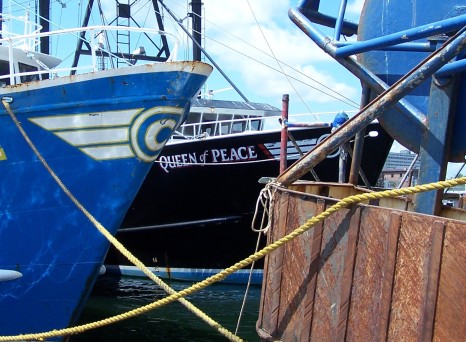 in place as part of a broad effort to alter the scope of New England’s fishing grounds. Peter Baker, director of northeast U.S. Oceans for Pew Charitable Trusts, said that with the recent approvals, the council remains “on a course to eliminate thousands of square miles of important fish habitat areas” in favor of commercial fishing concerns. He said the council has ignored conservationists’ (shrugs shoulders),,, Read the rest here 20:48
in place as part of a broad effort to alter the scope of New England’s fishing grounds. Peter Baker, director of northeast U.S. Oceans for Pew Charitable Trusts, said that with the recent approvals, the council remains “on a course to eliminate thousands of square miles of important fish habitat areas” in favor of commercial fishing concerns. He said the council has ignored conservationists’ (shrugs shoulders),,, Read the rest here 20:48
New England Fishery Management Council expected to vote on opening scallop grounds
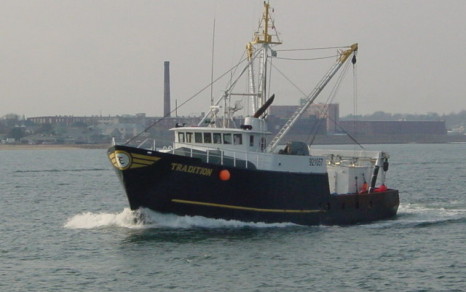 The New England Fishery Management Council on Thursday will take up the subject of opening parts of Georges Bank to scallop fishing, in some cases after closures of 20 years that led to an untapped abundance of scallops, according to surveys. Wednesday’s meeting of the council, day two of three, offered a preview of how the council, and by extension NOAA Fisheries, intends to proceed. “Don’t be bullied” by the environmentalists, Maggie Raymond of the Associated Fisheries of Maine urged the 17-member council. Read the rest here 09:22
The New England Fishery Management Council on Thursday will take up the subject of opening parts of Georges Bank to scallop fishing, in some cases after closures of 20 years that led to an untapped abundance of scallops, according to surveys. Wednesday’s meeting of the council, day two of three, offered a preview of how the council, and by extension NOAA Fisheries, intends to proceed. “Don’t be bullied” by the environmentalists, Maggie Raymond of the Associated Fisheries of Maine urged the 17-member council. Read the rest here 09:22
Scallop Sparks flying in advance of New England Fishery Management Council meeting
 The scallop industry is on high alert over next week’s meeting of the New England Fishery Management Council after a long warning letter was sent to the council by NOAA
The scallop industry is on high alert over next week’s meeting of the New England Fishery Management Council after a long warning letter was sent to the council by NOAA Fisheries Regional Administrator John Bullard. The council’s Habitat Committee has issued recommendations that fishing restrictions be lifted on several areas of Georges Bank, the Gulf of Maine and the South Channel. But Bullard, backed by his agency’s scientific staff, said he believes that the relaxing of the restrictions would set back the effort to nurse fish stocks back to health. Read the rest here 22:03
Why is Ottawa drawing a blank on Georges Bank?
 The productivity of this bank is witnessed by the largest year class of haddock (2010) that has been recorded in the last 50 years. You would think that governments responsible for managing this unique ocean area would want to protect it from . A blowout similar to the recent Deep Water Horizon disaster in the Gulf of Mexico would be devastating to many fishing communities in southwestern Nova Scotia and New England. Eighty per cent of Georges Bank lies in American waters. Read the rest here 11:30
The productivity of this bank is witnessed by the largest year class of haddock (2010) that has been recorded in the last 50 years. You would think that governments responsible for managing this unique ocean area would want to protect it from . A blowout similar to the recent Deep Water Horizon disaster in the Gulf of Mexico would be devastating to many fishing communities in southwestern Nova Scotia and New England. Eighty per cent of Georges Bank lies in American waters. Read the rest here 11:30
George’s Bank at Risk: Shell’s N.S. project assessment in last stage
 Shell Canada Inc. was another step closer Wednesday to exploratory drilling off the coast of Nova Scotia after an environmental assessment moved into its final phase. “We remain on track for a mid-2015 commencement of exploratory drilling,” Larry Lalonde, a Shell Canada spokesman, said in an interview. “There is a significant possibility of oil reaching George’s Bank and the southwest coast of the province in the event of a blowout,” Joanne Cook, marine toxics co-ordinator with the centre, said in an interview. Read the rest here 10:41
Shell Canada Inc. was another step closer Wednesday to exploratory drilling off the coast of Nova Scotia after an environmental assessment moved into its final phase. “We remain on track for a mid-2015 commencement of exploratory drilling,” Larry Lalonde, a Shell Canada spokesman, said in an interview. “There is a significant possibility of oil reaching George’s Bank and the southwest coast of the province in the event of a blowout,” Joanne Cook, marine toxics co-ordinator with the centre, said in an interview. Read the rest here 10:41
NoRigs 3 calls on Harper government to extend Georges Bank drilling moratorium
 For the third time in three decades a coalition of fisheries groups and environmentalists is campaigning to prevent oil and gas drilling on Nova Scotia’s lucrative Georges Bank fishing grounds. The group, known as NoRigs 3, is calling on the Harper Government to extend a federal moratorium that expires at the end of 2015. Nova Scotia legislature unanimously passed a law in 2010 extending a provincial moratorium until 2022. Read the rest here 10:37
For the third time in three decades a coalition of fisheries groups and environmentalists is campaigning to prevent oil and gas drilling on Nova Scotia’s lucrative Georges Bank fishing grounds. The group, known as NoRigs 3, is calling on the Harper Government to extend a federal moratorium that expires at the end of 2015. Nova Scotia legislature unanimously passed a law in 2010 extending a provincial moratorium until 2022. Read the rest here 10:37
Voracious protected seals starting to overrun waters off New England
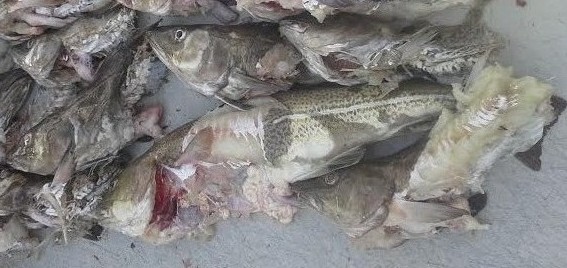 But what is the cost? Nils Stolpe, a Florida-based fishing industry journalist and advocate, calculated that since each seal consumed 5 percent of its body weight each day in squid, mollusks, crustaceans, and a variety of fish including rockfish, herring, flounder, salmon, hake, and lance, and don’t forget cod, it amounts to q a quarter million pounds daily. Annually he added it up to 450,000 million pounds, about 200,000 metric tons. Read the rest here 07:07 Read Dogfish and seals and dolphin, oh my! by Nils Stolpe here
But what is the cost? Nils Stolpe, a Florida-based fishing industry journalist and advocate, calculated that since each seal consumed 5 percent of its body weight each day in squid, mollusks, crustaceans, and a variety of fish including rockfish, herring, flounder, salmon, hake, and lance, and don’t forget cod, it amounts to q a quarter million pounds daily. Annually he added it up to 450,000 million pounds, about 200,000 metric tons. Read the rest here 07:07 Read Dogfish and seals and dolphin, oh my! by Nils Stolpe here






